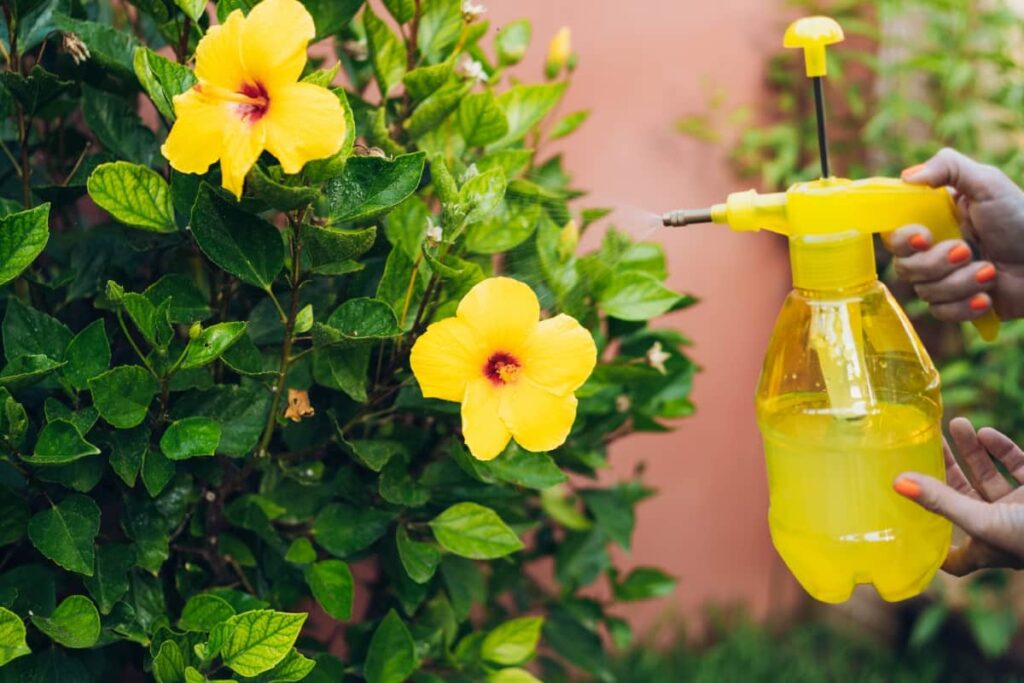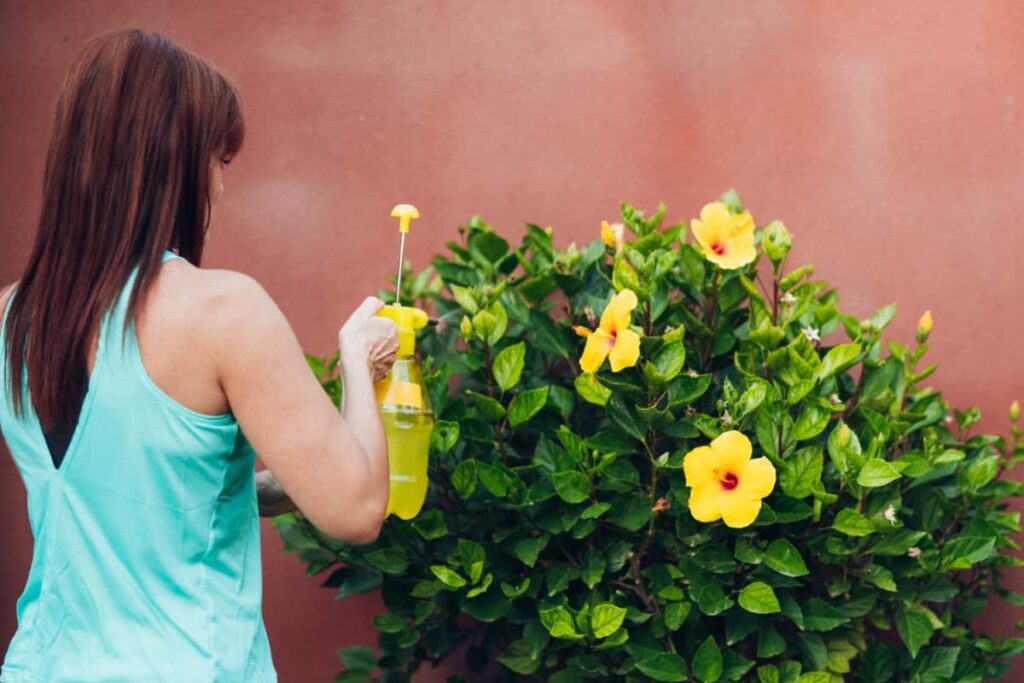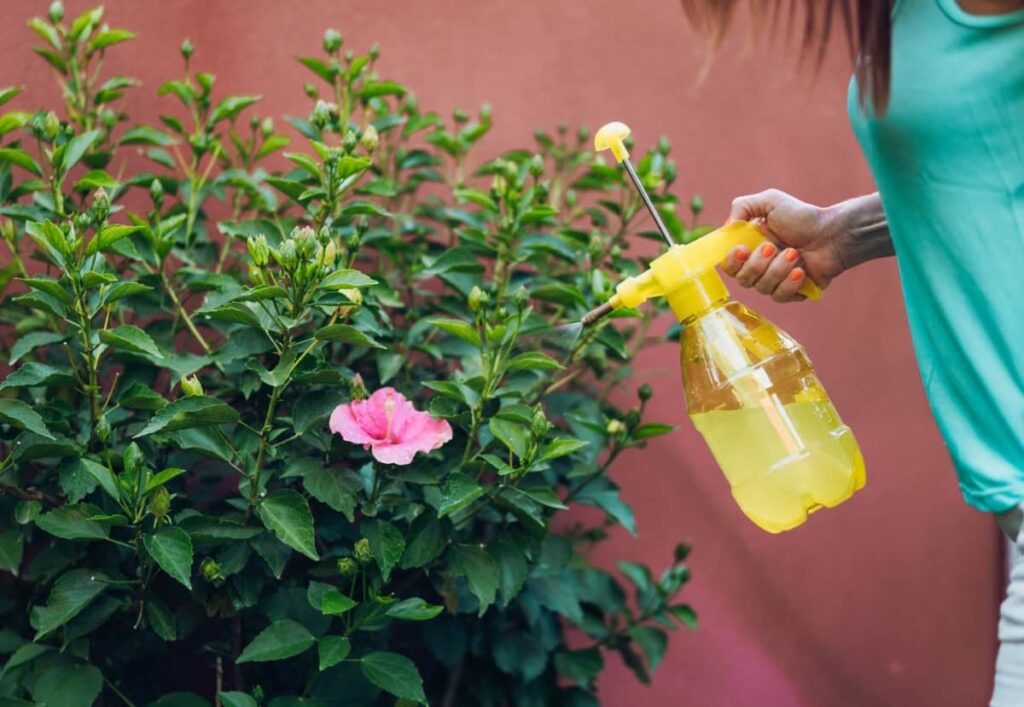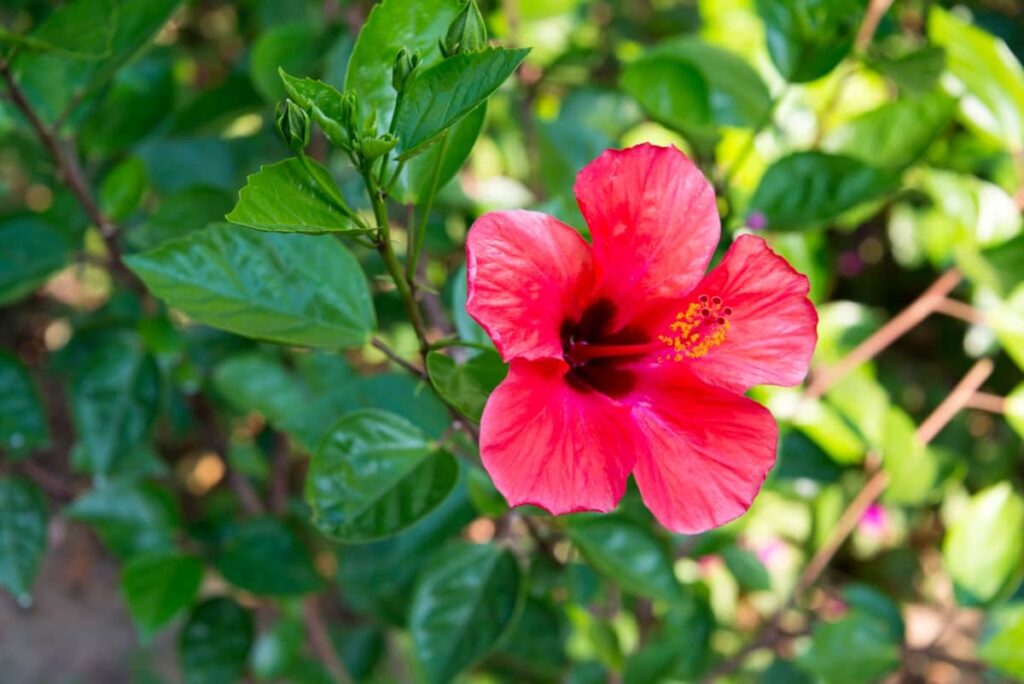In this guide, we’ll explore the ten best natural pesticides for hibiscus plants that are not only effective in controlling pests but are also gentle on the environment, pets, and beneficial insects.

10 Best Natural Pesticides for Hibiscus Plants
Neem Oil
Application Methods of Neem Oil for Hibiscus Pests
Neem oil, extracted from the neem tree seeds, is a potent natural pesticide for hibiscus plants. Apply diluted neem oil using a spray bottle. Mix neem oil (1-2 tablespoons) with water and a few drops of dish soap. Spray on both sides of hibiscus leaves. Apply every 7-14 days or after rain for continuous protection. Neem oil serves as a holistic solution, ensuring the well-being of your hibiscus plants.
Benefits for Hibiscus
- Pest Repellent: Neem oil acts as a potent natural insect repellent, effectively combating hibiscus bugs.
- Fungal Control: It also prevents fungal diseases, keeping hibiscus plants healthy.
- Nutrient Boost: Neem oil enhances soil fertility, promoting robust growth and vibrant blooms.
Insecticidal Soap
Effective Pests
Organic Insecticidal Soap Hibiscus is a natural pest control option derived from potassium salts of fatty acids. It’s effective against pests like aphids, mealybugs, and spider mites. Also, Insecticidal soap works best against soft-bodied pests such as whiteflies and mealybugs.
Usage Guidelines
- Dilute insecticidal soap according to instructions on the label, typically 2-5 tablespoons per gallon of water.
- Apply in the early morning or late evening to avoid sunlight, which can cause leaf burn.
- Ensure thorough coverage of both upper and lower leaf surfaces where pests reside.
- Repeat applications every 7-10 days or as needed until pests are controlled.
Garlic Spray
Preparation and Use
To the homemade garlic pesticide recipe, finely chop or crush some cloves of garlic and soak them in mineral oil for 24 hours. Then, strain the solution and add a teaspoon of liquid soap per pint of strained liquid. Dilute this concentrate with water (1 part concentrate to 10 parts water). Spray the solution onto plants, focusing on the undersides of leaves where pests often hide. Reapply every 7-10 days or after rain.
Targeted Pests
Garlic spray is effective against a wide range of pests, including aphids, whiteflies, spider mites, and caterpillars. The strong odor of garlic repels these pests and can also disrupt their feeding and reproductive cycles, reducing their populations over time. Additionally, garlic spray acts as a deterrent for larger pests like rabbits and deer, making it a versatile solution for gardeners seeking natural pest control methods.
Chili Pepper Spray Pest Control
Recipe and Application
Mix 2 tablespoons of chili powder or 5-10 chopped hot peppers with 1 quart of water and a few drops of dish soap. Allow it to steep for 24 hours, then strain and transfer to a spray bottle. Shake well prior to use and spray directly onto plants, focusing on areas where pests are present. Reapply after rain or every few days as needed.
Pest Control Spectrum
- Repellent: The spicy nature of chili peppers deters pests such as aphids, caterpillars, and slugs from feeding on plants.
- Contact Irritant: Upon contact, the capsaicin in chili peppers causes irritation to pests, encouraging them to avoid the sprayed area.
- Environmentally Friendly: Compared to chemical pesticides, chili pepper spray is safer for the environment, beneficial insects and human health.
In case you missed it: 10 Reasons Why Your Hibiscus Buds are Falling Off: Prevention and Remedies

Diatomaceous Earth (DE)
Application Around Hibiscus
Diatomaceous earth is a natural pest control powder composed of fossilized diatoms, which are microscopic algae skeletons. When applied around hibiscus plants, DE serves as a versatile pest control solution. Diatomaceous Earth Slugs Hibiscus can be applied as dust. Dusting the soil around hibiscus plants and applying a thin layer on foliage can effectively target pests while minimizing harm to beneficial insects.
Types of Controlled Pests
- Insects: DE effectively controls various insect pests, including aphids, whiteflies, beetles, and caterpillars, by physically damaging their exoskeletons, leading to dehydration and death.
- Snails and Slugs: The abrasive texture of DE creates a barrier that deters snails and slugs from approaching hibiscus plants, reducing feeding damage.
- Nematodes: Although less effective against nematodes, DE can help deter and manage certain species that inhabit the soil around hibiscus roots.
Horticultural Oil
Spraying Techniques
Ensure thorough coverage by spraying horticultural oil evenly on all plant surfaces, including the undersides of leaves where pests often hide. Use a handheld sprayer or a hose-end sprayer for smaller plants and a pump sprayer for larger ones. For horticultural oil aphids treatment, apply in the morning or evening to avoid leaf burn and when temperatures are above 21°C and winds are calm.
Safe Use on Hibiscus
Before applying horticultural oil, perform a test spray on a small portion of the hibiscus plant and monitor for adverse reactions for 24 hours. Avoid spraying during flowering to prevent damage to delicate blooms and to protect beneficial pollinators. Follow the manufacturer’s instructions regarding dilution rates and application frequency to ensure safe and effective use on hibiscus plants.
Bacillus thuringiensis (Bt)
Targeted Insect Larvae
Bacillus thuringiensis caterpillars Hibiscus’ primary target is insect larvae, making it an environmentally friendly alternative to chemical pesticides. Bt specifically targets the larvae of various pests, such as caterpillars, beetles, and mosquitoes. The bacterium produces proteins toxic to these larvae, disrupting their digestive systems and leading to their demise while sparing non-target organisms.
Application Timing
It’s most effective when applied during the early stages of larval development, ensuring ingestion of the toxin during the vulnerable feeding period. Proper timing of application enhances its effectiveness, making it a valuable pest control tool in integrated pest management strategies while minimizing harm to non-target organisms and the environment.
Epsom Salt Solution
Benefits of Epsom Salt Hibiscus Health
Epsom salt, rich in magnesium and sulfate, facilitates essential nutrient absorption in plants, promoting chlorophyll production, photosynthesis, and overall growth. Magnesium aids in enzyme activation, promoting robust root development, while sulfate supports nutrient uptake and synthesis of proteins crucial for plant structure and function.
Method of Application
Dissolve 1-2 tablespoons of Epsom salt per 4 liters of water and apply as a soil drench or foliar spray. For optimal results, administer every 2-4 weeks during the growing season, adjusting dosage based on plant needs and soil conditions. Ensure thorough coverage, avoiding excessive application to prevent salt buildup.
Vinegar Spray
Dilution Ratios
For hibiscus plants, a vinegar spray serves as a potent natural pesticide. Prepare a vinegar water solution by diluting vinegar and water in a ratio of 1:1 for a gentle yet effective solution. Apply it directly to affected areas, targeting pests like aphids, mealybugs, and spider mites.
Precautionary Measures
Exercise caution to avoid damaging plant tissues by testing on a small area first while using pyrethrin natural insecticide plants. Apply the diluted vinegar spray in the morning or evening to prevent sunburn on foliage. Regularly monitor plant health and adjust treatment frequency as needed. This organic approach minimizes harm to beneficial insects and promotes a healthy hibiscus garden.
In case you missed it: Hibiscus Farming Outdoors and Indoors Information

Pyrethrin
Mode of Action
Derived from chrysanthemum flowers, pyrethrin disrupts insects’ nervous systems upon contact, causing paralysis and eventual death. It targets sodium channels, leading to hyperexcitation and paralysis.
Application Tips
- Dilute according to instructions to avoid toxicity to non-target organisms.
- Apply during cooler times of the day to prevent degradation due to sunlight.
- Rotate with other insecticides to prevent resistance development.
- Avoid application in windy conditions to prevent drift.
- Reapply after rainfall for continued efficacy.
In case you missed it: 10 Reasons Why Your Marigold is Not Blooming: 100% Effective Solutions for Flowering Issues in Marigold Plant

Conclusion
Whether you’re dealing with an infestation or looking for preventative measures to keep your hibiscus plants healthy, these natural pesticides offer a safe and sustainable solution. Happy gardening!
- Management Pests and Diseases in Your Cotton Field
- Sheep Farming Business Plan for Beginners
- Aquaponic Farming at Home: A Step-By-Step Guide
- Profitable Village Farming Business Ideas in 2024
- High-Yield Aquaculture: Fast-Growing Fish for Farming
- Effective Fish Pond Construction Techniques for Beginners
- Irrigation and Water Management in Pineapple Farming
- Blossom to Harvest: Mastering Flowering and Pollination in Papaya Farming
- Pig Fattening Essentials: From Selection to Sale for Beginners
